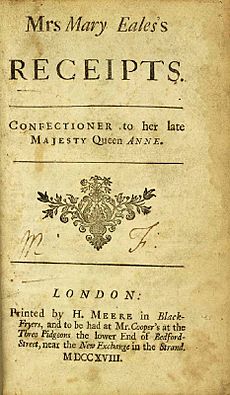Mary Eales facts for kids
Mary Eales (died around 1718) was a famous writer who created a cookbook called Mrs Mary Eales's Receipts. This book, published in 1718, was all about cooking and making sweet treats. Most of what we know about her comes from the title pages of her book's different versions. She likely died in 1718, but we know for sure she was gone by 1733 because later books called her "the late ingenious Mrs Eales." Her book said she was a special baker for King William and Queen Anne, but royal records don't show her as an employee.
Contents
Who Was Mary Eales?
We don't know much about Mary Eales's personal life. A historian named Sara Pennell, who studied Eales, says that all the information we have comes from her published works. We don't know when she was born or who her parents were. We also don't know if "Eales" was her family name or if she got it through marriage.
Early Copies of Her Book
Mary Eales's cookbook, Mrs Mary Eales's Receipts, was around even before it was printed. A handwritten copy from 1711 was owned by Elizabeth Sloane, the daughter of Sir Hans Sloane. Other handwritten copies were also shared in 1713, costing five guineas each. This was a lot of money back then!
Confectioner to Royalty?
The first printed version of her book came out in 1718. It was 100 pages long and didn't have an introduction. The title page said Eales was the "Confectioner to her late majesty Queen Anne." A confectioner is someone who makes sweets and pastries.
However, historian Sara Pennell looked at the records for Queen Anne's royal household. She found no one named Mary Eales working there. Another historian, Gilly Lehman, thinks Eales might not have been a direct employee. Instead, she might have been an outside supplier. This means she could have provided special sweets to the royal court that their own kitchens didn't make. By the 1733 edition of her book, the description changed. It then said she was a confectioner to "their late majesties King William and Queen Anne."
Mary Eales's Famous Recipes
Mary Eales's book is important because it contains some of the earliest recipes for popular foods.
The First "Jam" Recipe
The word "jam" appeared very early in Mrs Mary Eales's Receipts. Her recipe for jam was different from what was common at the time. Most jams were solid enough to be sliced and eaten. But Eales's recipe made a more runny food. It was stored in jars and sealed with a paper lid. This sounds much more like the jam we know today!
The First Ice Cream Recipe
Her book also has the first recorded recipe for ice cream in English. People in Britain had eaten ice cream as early as 1671. But Mary Eales was the first to write down how to make it in a book.
Historian Kate Colquhoun described the recipe as "confident, practical and details." Food historian Laura Mason said it was simple. It involved cream that was sweetened and had fruit flavoring added. The famous cookery writer Elizabeth David believed Eales's recipe came from a French source.
How to Make Ice Cream (Eales's Recipe)
The recipe, called "To Ice Cream," explains how to freeze cream and fruit:
Take Tin Ice-Pots, fill 'em with any Sort of Cream you like, either plain or sweeten'd, or Fruit in it; shut your Pots very close; to six Pots you must allow eighteen or twenty Pound of Ice, breaking the Ice very small; there will be some great Pieces, which lay at the Bottom and Top.
You must have a Pail, and lay some Straw at the Bottom; then lay in your Ice, and put in amongst it a Pound of Bay-Salt; set in your Pots of Cream, and lay Ice and Salt between every Pot, that they may not touch; but the Ice must lie round them on every Side; lay a good deal of Ice on the Top, cover the Pail with Straw, set it in a Cellar where no Sun or Light comes, it will be froze in four Hours, but it may stand longer; than take it out just as you use it; hold it in your Hand and it will slip out.
When you wou'd freeze any Sort of Fruit, either Cherries, Rasberries, [sic] Currants, or Strawberries, fill your Tin-Pots with the Fruit, but as hollow as you can; put to 'em Lemmonade, [sic] made with Spring-Water and Lemmon-Juice sweeten'd; put enough in the Pots to make the Fruit hang together, and put 'em in Ice as you do Cream.
Later Editions and Her Death
By 1733, a new edition of her book was published. It was renamed The Compleat Confectioner. The front page of this book mentioned "the late ingenious Mrs Eales." It also said the book was published "with the consent of her executors." This means she had passed away.
It's not clear exactly when Mary Eales died. Historian Sara Pennell thinks she might be the Mary Eales who was buried in St Paul's, Covent Garden, on January 11, 1718. If this is true, then Mary Eales was married and had a daughter named Elizabeth. She left her property and money to her daughter.


